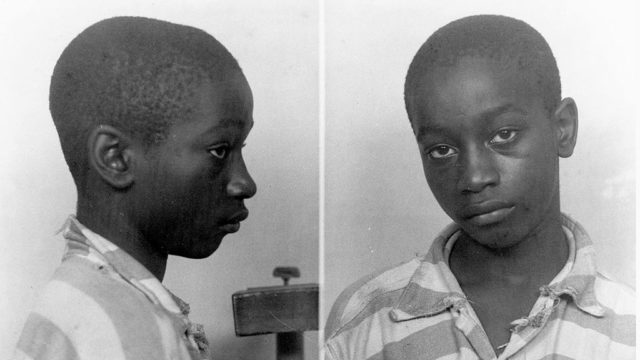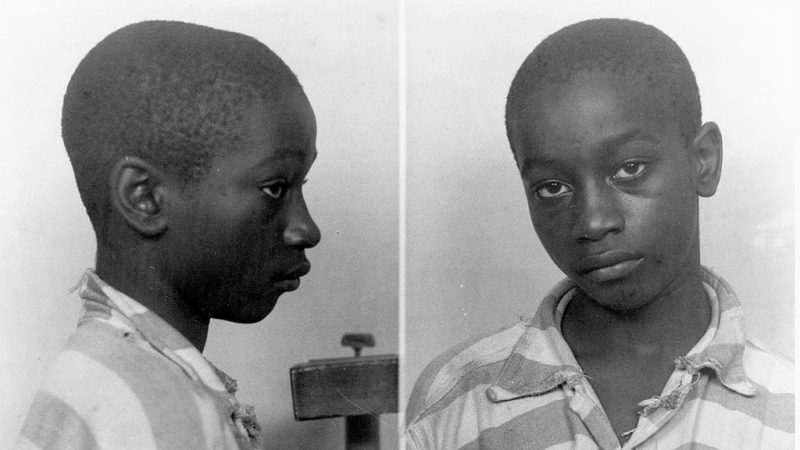Stinney, who was black, was arrested for murdering two white girls, Betty June Binnicker, 11 years old, and Mary Emma Thames, eight years old, in Alcolu, located in Clarendon County, South Carolina, on March 23, 1944. Stinney was convicted in less than 10 minutes, during a one-day trial, by an all-white, all male jury for first-degree murder. There was no written record of his confession apart from notes provided by an investigating deputy, and no transcript of the brief trial. He was denied an appeal and was executed by electric chair.
According to the confession, Stinney wanted to “have sex with” 11-year-old Betty June Binnicker and could not do so until her companion, Mary Emma Thames, age 8, was removed from the scene; thus he decided to kill Mary Emma. When he went to kill Mary Emma, both girls “fought back” and he thus decided to kill Betty June, as well, with a 15-inch railroad spike that was found in the same ditch a distance from the bodies.

According to the accounts of deputies, Stinney apparently had been successful in killing both at once, causing major blunt trauma to their heads, shattering the skulls of each into at least 4-5 pieces. The next day, Stinney was charged with first-degree murder.
The girls were last seen riding their bicycles looking for flowers. As they passed the Stinney property, they asked young George Stinney and his sister, Aime, if they knew where to find “maypops”, a local name for passionflowers. According to Aime, she was with George at the time of the murders. When the girls did not return home, search parties were organized. George’s father was among the searchers. The bodies of the girls were found the next morning on the black side of town in a ditch filled with muddy water.
Following George’s arrest, his father was fired from his job at the local sawmill, and the Stinney family had to immediately vacate the housing provided by Stinney Sr’s employer. The family feared for their safety. His parents did not see George again before the trial. He had no support during his 81-day confinement and trial; he was kept at a jail in Columbia 50 miles from town because of the risk of lynching. Stinney was questioned alone, without his parents or an attorney. Although the Sixth Amendment guarantees legal counsel, it was not until 1963 that Gideon v. Wainwright explicitly required representation through the course of criminal proceedings.
The entire proceeding against Stinney, including jury selection, took one day. Stinney’s court-appointed defense counsel was Charles Plowden, a tax commissioner campaigning for election to local political office. Plowden did not challenge the three police officers who testified that Stinney confessed to the two murders, despite this being the only evidence against him, and despite the prosecution’s presentation of two different versions of Stinney’s verbal confession.

The execution of George Stinney was carried out at the Central Correctional Institution in Columbia on June 16, 1944, at 7:30 p.m. Standing 5 feet 1 inch (155 cm) tall and weighing just over 90 pounds (40 kg), Stinney was so small compared to the usual adult prisoners that law officers had difficulty securing him to the frame holding the electrodes. The state’s adult-sized face-mask did not fit him; as he was hit with the first 2,400 V surge of electricity, the mask covering his face slipped off. Stinney was declared dead within four minutes of the initial electrocution. From the time of the murders until Stinney’s execution, 83 days had passed.
Until today, the Stinney case has been regarded as controversial because it has not really satisfactorily been solved and because the investigations and judicial process showed severe shortcomings. It was later found that a beam with which the two girls had been killed weighed over twenty pounds. It was ruled that George wasn’t able to lift the beam, let alone swing it hard enough to kill the two girls.
